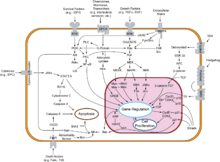


The G1/S transition is a stage in the cell cycle at the boundary between the G1 phase, in which the cell grows, and the S phase, during which DNA is replicated.[1] It is governed by cell cycle checkpoints to ensure cell cycle integrity and the subsequent S phase can pause in response to improperly or partially replicated DNA.[2] During this transition the cell makes decisions to become quiescent (enter G0), differentiate, make DNA repairs, or proliferate based on environmental cues and molecular signaling inputs.[3] The G1/S transition occurs late in G1 and the absence or improper application of this highly regulated checkpoint can lead to cellular transformation and disease states such as cancer.[4][1]
During this transition, G1 cyclin D-Cdk4/6 dimer phosphorylates retinoblastoma releasing transcription factor E2F, which then drives the transition from G1 to S phase. The G1/S transition is highly regulated by transcription factor p53 in order to halt the cell cycle when DNA is damaged.[5]
It is a "point of no return" beyond which the cell is committed to dividing; in yeast this is called the Start point, and in multicellular eukaryotes it is termed the restriction point (R-Point).[2][6] If a cell passes through the G1/S transition the cell will continue through the cell cycle regardless of incoming mitogenic factors due to the positive feed-back loop of G1-S transcription.[2] Positive feed-back loops include G1 cyclins and accumulation of E2F.[2]
- ^ a b Bartek J, Lukas J (February 2001). "Pathways governing G1/S transition and their response to DNA damage". FEBS Letters. 490 (3): 117–22. doi:10.1016/S0014-5793(01)02114-7. PMID 11223026. S2CID 16090531.
- ^ a b c d Bertoli C, Skotheim JM, de Bruin RA (August 2013). "Control of cell cycle transcription during G1 and S phases". Nature Reviews Molecular Cell Biology. 14 (8): 518–28. doi:10.1038/nrm3629. PMC 4569015. PMID 23877564.
- ^ Massagué J (November 2004). "G1 cell-cycle control and cancer". Nature. 432 (7015): 298–306. Bibcode:2004Natur.432..298M. doi:10.1038/nature03094. PMID 15549091. S2CID 4428026.
- ^ Bartek J, Lukas J (February 2001). "Pathways governing G1/S transition and their response to DNA damage". FEBS Letters. 490 (3): 117–22. doi:10.1016/S0014-5793(01)02114-7. PMID 11223026. S2CID 16090531.
- ^ Lodish H, Berk A, Kaiser C, Krieger M (2012). Molecular Cell Biology (7th ed.). Freeman, W. H. & Company. ISBN 978-1-4641-0981-2.
- ^ Tenga MJ, Lazar IM (January 2013). "Proteomic snapshot of breast cancer cell cycle: G1/S transition point". Proteomics. 13 (1): 48–60. doi:10.1002/pmic.201200188. PMC 4123745. PMID 23152136.